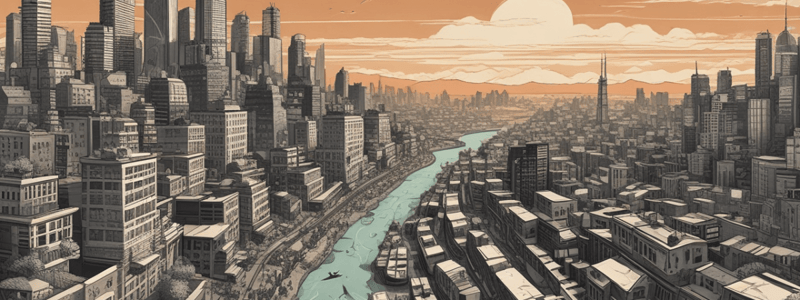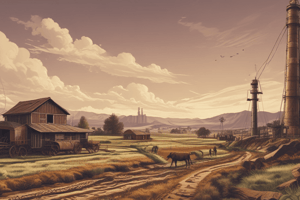Podcast
Questions and Answers
For most of human history, the majority of people have worked in ______ and so have lived in rural areas.
For most of human history, the majority of people have worked in ______ and so have lived in rural areas.
agriculture
The minority of people who lived in ______ areas of towns and cities relied on the much greater numbers of agricultural workers to provide food.
The minority of people who lived in ______ areas of towns and cities relied on the much greater numbers of agricultural workers to provide food.
urban
Changes in ______ practices meant fewer people were needed to keep the supply of food available.
Changes in ______ practices meant fewer people were needed to keep the supply of food available.
agricultural
As more countries around the world have become industrialised, so an increasing proportion of the world's population is living in ______.
As more countries around the world have become industrialised, so an increasing proportion of the world's population is living in ______.
This process of increased ______ living is called urbanisation.
This process of increased ______ living is called urbanisation.
Around the world, people feel attracted to the benefits of ______ areas.
Around the world, people feel attracted to the benefits of ______ areas.
Many people also feel pushed from the rural areas because there is little ______ and few prospects for improvement.
Many people also feel pushed from the rural areas because there is little ______ and few prospects for improvement.
______ does create some problems.
______ does create some problems.
Most people do not live very near their place of ______ and so they have to travel.
Most people do not live very near their place of ______ and so they have to travel.
Investigation Carry out some research to find out where in the world people are ______ through lack of food.
Investigation Carry out some research to find out where in the world people are ______ through lack of food.
Match the terms with their definitions:
Match the terms with their definitions:
Match the urbanisation effects with their descriptions:
Match the urbanisation effects with their descriptions:
Match the historical changes with their impacts:
Match the historical changes with their impacts:
Match the rural-urban differences with their characteristics:
Match the rural-urban differences with their characteristics:
Match the factors influencing urbanisation with their effects:
Match the factors influencing urbanisation with their effects:
Match the population changes with their causes:
Match the population changes with their causes:
Match the urbanisation outcomes with their descriptions:
Match the urbanisation outcomes with their descriptions:
Match the causes of urbanisation with their effects:
Match the causes of urbanisation with their effects:
Match the effects of urbanisation with their descriptions:
Match the effects of urbanisation with their descriptions:
Match the urbanisation stages with their characteristics:
Match the urbanisation stages with their characteristics:
Match the urbanisation factors with their influences:
Match the urbanisation factors with their influences:
Flashcards are hidden until you start studying
Study Notes
Urbanisation
- The majority of people have worked in agriculture and lived in rural areas throughout human history.
- Changes in agricultural practices in the 18th and 19th centuries led to fewer people being needed to maintain food supply, causing people to move to towns and cities.
- Urbanisation is the process of increased urban living, with more people moving to cities as countries become industrialised.
- Benefits of urban areas include a greater range of services, better facilities, and more amenities.
- Problems of urbanisation include:
- Traffic congestion and blocked roads
- Emissions from vehicles affecting air quality
- Pressure on services due to increased population
- Increased demand for drinking water and waste management
- Rising housing prices, making it difficult for certain groups to afford living in urban areas
- Decline of rural communities and local businesses
Climate Change
- Climate change refers to long-term changes to global or regional climate, including changes in temperature, rainfall, and other weather patterns.
- Greenhouse gases, such as those produced by human activities, trap heat from the Sun and contribute to global warming.
- Human activities that increase greenhouse gases include:
- Deforestation
- Burning fossil fuels
- Sending waste to landfill
- Agriculture
- Climate change is referred to as a 'crisis' due to its side effects, including:
- Rising sea levels affecting coastal areas
- Extreme weather causing flooding and droughts
- Long periods of drought leading to forest fires
- Melting of snow-covered areas like the Arctic, impacting wildlife
- Increased demand for water due to hotter weather
Studying That Suits You
Use AI to generate personalized quizzes and flashcards to suit your learning preferences.




